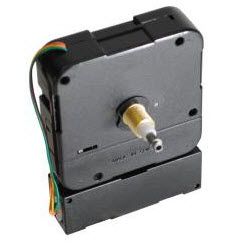Clock Parts

The How's as well as Whys of High Torque Clock Movements
Clock movements are the body and soul of any timepiece, whether analog or digital, whether modern-day or antique. Clock movements are likewise known as electric motors, and their function is to revolve the hands on a constant basis so that the clock constantly portrays the appropriate time. Therefore, we're talking about a rotary electric motor that needs to apply a specific amount of minimum torque upon its load, the hands, to accomplish its task.
Clock movements are standard according to the most frequently made use of applications. What this means is that the motor is made to provide adequate torque to cover hand weights up to an offered limitation however can not turn minute hands (heavier than hour hands) evaluating more than this.
In technique the weight limitation for the most prominent clocks corresponds to a length of concerning 5 inches. Simply put, hands with sizes higher than 5 inches will certainly as a whole present also hefty a tons for the electric motor, triggering the turning to drag and even stop completely. Hands shorter than the limitation will certainly create the electric motor no problem.
Yet the material made use of to make the hand also comes into play. Light metals such as tin or aluminum provide a smaller load than ones made from brass, for instance. So the 5-inch standard is a catchall quantity, and also conventional movements may have not a problem transforming light-weight hands longer than this.
The traditional method of structure movements was simply mechanical. The driving force was a snugly wound springtime or a hanging weight putting pressure on a wheel to transform. To stop the wheel from turning easily and also too quickly it was regulated through an escapement and pendulum in mix.
The mechanism was calibrated such that the pendulum ticked as soon as a second. Gears in fixed proportions formed a network all driven by the flywheel, and also the various hands were placed on pins that turned at precisely the right rate.
Today's clock motion operates online instead of mechanically. A quartz crystal produces resonances that occur at an accurately determined frequency. Numerical checking registers complete community of the crystal frequency right into appropriate timekeeping worths.
The hands in the digital version operate the same way as in the mechanical variation, however powering their rotations is easier. As opposed to a drivetrain, pendulum, as well as escapement plan the power is electric and the rotational regularity is stemmed from the checking registers going across mathematical thresholds.
Currently, we are used to visualizing traditional clock dials when we discuss hand position, but that's not constantly the instance. There are wrist watches that actually reveal weather condition sensations, such as temperature or humidity or especially tide level. Sometimes these look like specialized faces, and occasionally an unique dial-and-hand setup is incorporated into a bigger clock dial.
One more aberration from the norm is the 24-hour analog clock. Here, the hr hand makes a full circle daily rather than twice a day. A special dial is utilized showing labels for the complete set of 24 hours, typically needing a bigger size and also likewise bigger hands.
Certainly, when the clock face is unconventional, the activity needs to be adjusted to it to make sure that the hands line up effectively. However no matter the application, all hands have to be turned, some a full 360 degrees, others backward and forward through a restricted arc. As well as such turning calls for torque from the electric motor.
As stated before, typical movements are furnished to deal with loads that are frequently located in the majority of applications. However larger clocks (more than, say, 14" in size) utilize longer as well as therefore heavier hands than typical. Additionally, normal-sized hands constructed of much heavier materials might go beyond the lots tolerances of a typical activity.
However it is commonly the instance that movement functionality is copied in a high torque variation. Thus the individual must look for such different variations if needed. And that's all one requires to learn about high torque clock movements high torque quartz pendulum movements
